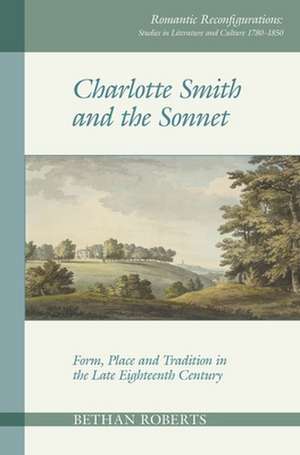Charlotte Smith and the Sonnet – Form, Place and Tradition in the Late Eighteenth Century: Romantic Reconfigurations: Studies in Literature and Culture 1780-1850
Autor Bethan Robertsen Limba Engleză Paperback – 12 noi 2019
intertwined concerns: with tradition, place and the sonnet form itself, whereby the subjects of Smith's sonnets - across birds, rivers, the sea, plants and flowers - are bound up with the literary context in which she wrote. Charlotte Smith and the Sonnet shows that Smith's verse engages more deeply
with tradition than has hitherto been realised and revises our understanding not only of Smith's career but also of the sonnet in eighteenth-century England. The book also illuminates Smith's place in posterity, as a popular poet - influencing figures ranging from Wordsworth and Coleridge to
Constable - who was subsequently obscured in literary history. It reveals the complex processes underpinning Smith's reception and paradoxical position from the late eighteenth century to the present day, and shows that the appropriation of place itself was an important way in which aspects of
literary tradition have been negotiated and understood by Smith, her predecessors, contemporaries and successors.
Preț: 187.03 lei
Nou
Puncte Express: 281
Preț estimativ în valută:
35.79€ • 37.46$ • 29.79£
35.79€ • 37.46$ • 29.79£
Carte disponibilă
Livrare economică 11-25 martie
Livrare express 22-28 februarie pentru 20.63 lei
Preluare comenzi: 021 569.72.76
Specificații
ISBN-13: 9781789620177
ISBN-10: 1789620171
Pagini: 192
Dimensiuni: 156 x 234 x 11 mm
Greutate: 0.28 kg
Editura: Liverpool University Press
Seria Romantic Reconfigurations: Studies in Literature and Culture 1780-1850
ISBN-10: 1789620171
Pagini: 192
Dimensiuni: 156 x 234 x 11 mm
Greutate: 0.28 kg
Editura: Liverpool University Press
Seria Romantic Reconfigurations: Studies in Literature and Culture 1780-1850
Descriere
This book explores Charlotte Smith's Elegiac Sonnets and clarifies its `place' - understood in multiple ways - in literary history. It argues that Smith's work engages more deeply with tradition than has hitherto been realised and revises our understanding not only of Smith's career but also of the sonnet in eighteenth-century England.










